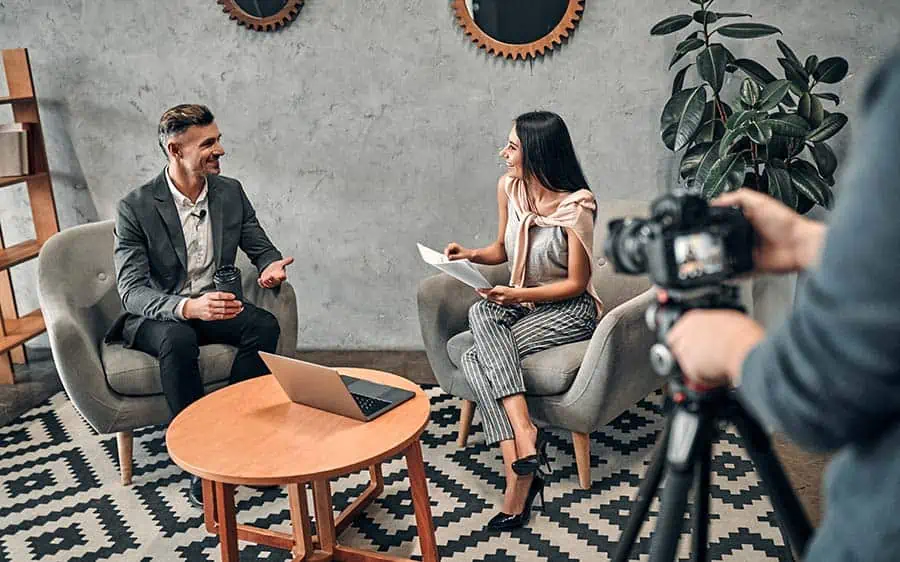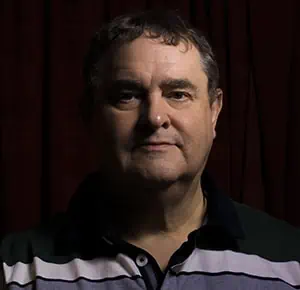Author: Tosh Lubek Published: 9th February 2024
DIY Video Studio is supported by its readers who use the affiliate links or ads on this site. As an Amazon Associate, I earn from qualifying purchases. Thank your support if you use any of the links.
Lights, camera, what color of clothing to wear?

Stepping onto the TV or social media video stage might feel daunting, but mastering your TV interview outfit can be the secret weapon you didn’t know you needed.
From what color looks best on TV to camera-friendly fabrics, this guide unravels the mysteries of what to wear on a TV interview, ensuring you radiate confidence and professionalism while captivating your audience.
So, read on and unlock the secrets to how to dress for a TV appearance.
Tip 1: Color Confidence: What color works best on TV

Ultimately, the best color for your TV interview appearance is the one that makes you feel comfortable, confident, and prepared to deliver your message with impact and shine in the interview. This means you should think about your skin tone and hair color. Colors that flatter your natural coloring will make you look your best. But having said that, you need to temper that choice with the needs of TV or video technology.
So, what color should you wear for a TV interview? Generally, solid neutral colors like blue, green, gray, and beige often work best on TV and video. They exude professionalism and avoid distracting viewers with bold colors. Pastels, or lighter shades of blue, green, or pink can also work well and soften your look and appear friendly and approachable.
Avoid wearing pure white clothing, and to a lesser extent, pure black. These can cause issues, especially the white which can appear washed out or blown out, when the camera exposure is adjusted for what is known as middle gray.
Instead of pure white, opt for ivory or an off-white.
Black is less troublesome technically than pure white, but it can appear heavy on camera. Use it strategically rather than as a dominant color (I know technically black isn’t a color, but bear with me), and pair it with a brighter article of clothing to avoid looking too dark.
Unless you have a very good reason for doing so, avoid bright neon colors, since they will appear harsh and visually jarring on screen. However, if it’s broadcast TV, a Broadcast Safe filter will be used to automatically keep color and brightness levels within the broadcast-safe range. Even so, you’re probably not a children’s entertainer and therefore unlikely to choose these colors.
Other colors to avoid include those that may blend in with the background, making it difficult to distinguish you from the background. This is especially true if you are to be interviewed in front of a green or blue screen. In such circumstances, choose clothing that does not include any green/blue, since these areas will appear as “holes” in your clothing when the chromakey effect is applied.
Tip 2: Fantastic Fabrics for TV Interviews and those to avoid

Although patterns and prints aren’t colors, these need to be considered alongside color. Busy fine patterns can create a moiré effect of wavy lines on the screen. This is because the lines in the pattern can mismatch with the lines of pixels on the camera’s sensor. This results in the moiré pattern on the screen that becomes more noticeable when the person moves, causing the pattern and the pixel lines to interact. The moiré pattern then becomes more of a distraction as it “dances” on the screen.
Other fabric options to avoid are metallic fabrics and those with sequins. Their reflective nature can create unwanted shimmer and reflections under studio lights. Stick to matte finishes or subtle textures for a polished look that won’t distract viewers.
So, when choosing a pattern or print, avoid ones that are fine, but if you go too bold with the pattern that can be distracting because it draws the viewer’s attention away from what you are saying.
Also, don’t let your message be overshadowed by creases and wrinkles. So, forget fabrics like linen or cotton, they’re notorious for holding onto creases. Whereas wool and synthetics are better at resisting creases and wrinkles. Shirts and blouses that are made from a blend of cotton with synthetics are often a better choice than those made from 100% cotton fabric.
Remember, your outfit is an extension of your professionalism. By choosing camera-friendly fabrics, you ensure your message, not your wardrobe, takes center stage, leaving a lasting impression for all the right reasons.
Tip 3: Suit Up for Success: Mastering the Button Dance

Looking sharp matters! But when it comes to your suit jacket, buttoning etiquette varies: Standing tall? Button up! Show confidence and polish with a fully fastened jacket. Taking a seat? Unbutton it! Relax and avoid constriction for comfortable conversation.
It’s all about striking the right balance between professionalism and ease. Button wisely to ace your interview with both style and comfort!
Tip 4: Halt the glare so you can shine!

Bold jewelry can be a statement piece, but under the glare of studio lights, too much sparkle and reflections can be a distraction on camera. Bulky pieces can also look cumbersome. So, embrace a minimalist elegance to ensure you’re not upstaged by your accessories. Remember, accessories should enhance your message, not overshadow it.
Glasses can also be a problem since they can reflect studio lights into the camera lens. If you don’t need them, take them off, or consider getting contacts or glasses with antireflective coatings.
Tip 5: Silence the Clangs: Keep Your Interview Noise-Free

Loose bracelets and layered bangles can jingle with every hand gesture, causing a noisy distraction. So, opt for simpler pieces that won’t jingle or clink, or remove them altogether.
Nervous fiddling with a necklace, or beads knocking against a lavalier microphone creates unwanted noise. Even your attire can also cause annoying noises. I once recorded a lady who was wearing leather clothing that “creaked” with her every move.
So, choose your jewelry and clothing carefully to ensure the audience focuses on the message!
Tip 6: Remove ID badges and lanyards!

ID badges and lanyards will compete for attention, pulling focus away from what your interview answers. There are always people who will try to read the details. So, opt for a clean, streamlined look that keeps the spotlight on you and your expertise.
Tip 7: Beat the Heat: Dress Cool and Look Confident

Traditional studio lights can turn up the heat, so ditch the heavy suit! Even with cool LED video lights, if you’re new to being interviewed, your nervousness can make you perspire and feel awkward.
Thick fabrics trap heat, causing you to feel uncomfortable and fidget on camera. This will convey your nervousness and even convey a sense of dishonesty. Wear lightweight and comfortable clothing so you can keep your cool and focus on your message with confidence to captivate the viewers.
Tip 8: Glow up for the camera with your personal grooming

If you have a light skin tone, consider using slightly darker makeup than usual. Studio lights can be bright, so a touch more definition helps you pop on screen.
Gents who sport a clean-shaven look, consider a pre-interview shave if you’re appearing later in the day. Stubble can appear more prominent on camera, especially 4K video.
If you’re bald, avoid the glare! A light dusting of powder on your head will minimize the shine from studio lights.
Don’t go mad if you’ve never applied make-up before, a little can go a long way. You’re not creating a second skin, but instead, enhancing your natural features.
About the author: Tosh Lubek is a multi-award-winning broadcaster, writer, and video producer, with 40 years of experience in professional broadcasting and has been using Canon video and stills cameras since 2010. He has worked with radio and TV broadcasters, advertising agencies, and direct clients on a variety of projects including radio and television advertising, online video production, corporate videos, award ceremony motion graphics, and theme park sound design. Tosh has won numerous awards, including a Radio Academy Awards Gold Sony, a Gold, Silver, and Bronze World Medals in the New York Festivals International Advertising Awards. Since about 2007 he has been creating YouTube videos. Tosh has been a sponsor of the “video booth” at HashTag Business Events across the UK.
Recent Posts
Premiere Pro Editors STOP Dragging Clips WRONG! Edit 10x FASTER
Hey there, Premiere Pro users! If you're dragging your video clips from the project panel to the timeline listen up, there's a better way! The program monitor holds some hidden editing superpowers...
Conquer Your Next Media Interview Like a Pro! (With 15 Actionable Hacks)
Feeling anxious about your upcoming interview? Don't worry, we've got you covered! Whether you're a seasoned professional or a first-timer, mastering the art of the media interview can be daunting....



